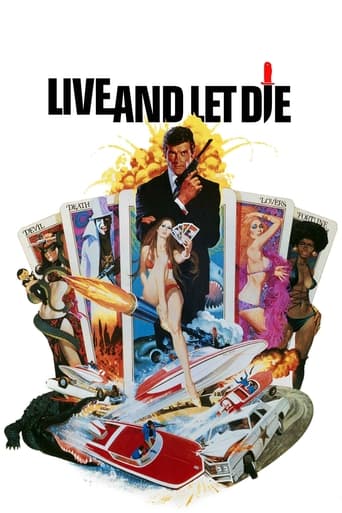

A combination of a 1930's serial mentality mixed in with deliciously silly comedy, this entry (the first of 7 with Roger Moore) goes back to the ideas first seen in "Dr. No". It has no limit to the outrageousness, having an opening where three agents are killed in nefarious ways, making Bond the next target. The world of black magic is explored, but there's much more to it than that. Bond faces some nefarious foes, including snakes, sharks and distantly related crocodiles and alligators, always in the most hysterical of ways.Joining Moore here is the beautiful Jane Seymour as a tarot card reader named Solitaire and Yaphet Kotto as a particularly sinister bad guy with some diabolical ways of dispatching his enemies. From the FDR Drive in Manhattan to the streets of New Orleans to the bayou (for a most delightful boat chase involving hick sheriff Clifton James), this will have you both laughing and on the edge of your seat. This is a crowd pleaser for sure, with the scene stealing Geoffrey Holder literally getting the last laugh.
... View MoreI fell in love with this bond entry right from the start. Roger Moore kicks it up a notch in this new take on the James Bond character, making his this over-the-top action star, with a lot of wit. The action spread throughout this film is fantastic, especially a very memorable chase in the river, but by the end of the film, you just can't help but wonder why they took so much time on the action, before getting back to a forgotten storyline. Also, there are some very odd ritual scenes in which I wondered why they included, but still, I had a terrific time during my viewing of this film and the direction and editing has gotten much much better. "Live and Let Die" is a fine entry to the bond canon.
... View MoreThe only worse James Bond with Roger Moore is "Octopussy", an exaggerated tale about a circus of thieves and villains. It's not even a good "Voodoo" movie; that honor goes to a 1940's Bob Hope entry called "Ghost Breakers". The whole production seems rather cheap and hurried by Bond Standards. All the major villains are black and stereotypical. Cheap production values make it seem like it's set on "Gilligan's Island", not Jamaica. Also filmed in Louisiana and Harlem. Goeffery Holder's performance is unforgettable as "The Baron", and there is a decent boat "dogfight". I don't even like the title theme song that much as it gives no clue as to the movie's plot and is not one of Paul McCartney's best, in my opinion. Disappointing, except for the Beautiful Bond Bikini Girls, of course! Eon Productions seemed uncomfortable with the whole "Black-Exploitation" thing. It's just OK. An under-performer and not even Roger Ebert liked it. Jane Seymour's portrayal (as "Solitaire") is a waste of her acting abilities.
... View MoreIt took a while for the Bond films to get back into form, but Live and Let Die was a big leap forward toward the greatness that were the first 3 films. We had a new Bond in Roger Moore here, and a great one I may add. I never really bought into Lazenby as Bond in 'On Her Majesty's Secret Service', but it took a matter of minutes before I bought into Moore as 007. In many ways I think this film hearkens back to Dr. No. It has the one villain focus, instead of the Spectre approach (which is good in its own right). But it also takes place on plenty of mysterious locations, very similar to Dr. No.While the plot doesn't have a global scale like almost every other Bond film does, Yaphet Kotto gives us a menacing turn as a drug lord who's killing ways are different than anything we have seen before in a Bond film. For me, it was a good change of pace from the Blofeld movies. Even though it's a much different story than the other films, Mr. Big was perhaps my favorite villain since Goldfinger, and most definitely the best overall film since then. I even found the smiling sidekick to be entertaining. I will say, I found it strange as to the drug lords obsession with using reptiles and amphibians to kill their enemies. First snakes, then crocodiles, and sharks?This film is famous for a few reasons, but it's theme song being near the top. It flows well with the themes of the actual film to go along with it's catchy hook. But I think some recognition should be given to Jane Seymour, who at 22 years of age, holds her own against Moore and Kotto. Not to mention the fact that she is still gorgeous to this day. Most of all, I think this film is more fun than the past few films. It's not as dry and far more realistic than previous entries. The action scenes aren't anything extraordinary and the few policeman sequences are just plain dumb, but Live and Let Die is loads of fun.+Refreshing entry+Good and unique Bond villain+Seymour+Theme song-Kooky police officers-Not a ton of action7.3/10
... View More